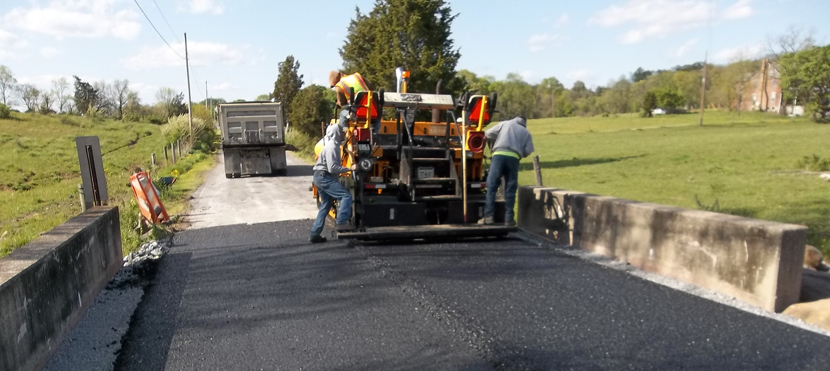Posts
5 Reasons You Should Consider a Roadway Pavement Management Program
/in Insights-Local Government, Insights-Municipal, Insights-Transportation, Uncategorized /by Judy LincolnCapital Improvement Planning Helps Londonderry Township Improve Bridge Conditions At Lower Cost
/in Insights-Municipal, Insights-Planning, Insights-Transportation /by Judy Lincoln
We regularly hear about the condition of infrastructure in the United States, and many times the news is bad. Too often we hear about underground pipes breaking, roads crumbling, and bridges that need to be closed. Fortunately, in Londonderry Township, bridge conditions are actually pretty good.
Londonderry Township is specifically responsible for 13 bridges, all of which cross waterways and are less than 20’ in length. Closing any one of these bridges for safety concerns could cause a significant disruption to emergency access and general traffic flow. To avoid this, Londonderry Township asked HRG to assess all 13 structures and prioritize their maintenance and replacement needs. Our evaluation indicated that all 13 bridges were likely more than 50 years old, and six of them should be replaced within the next 3 – 10 years.
HRG worked with the township to create an approach to address this pressing infrastructure need without overburdening the township’s annual budget. The initial concept was to replace one bridge every other year for the six most critical structures. This would allow us to address the township’s most urgent needs without being forced into an emergency situation. It would also allow us to identify alternative funding for each bridge replacement and carefully plan any necessary road closures to minimize traffic interruption.
Londonderry’s program is a perfect example of infrastructure asset management and capital improvement planning. HRG has written extensively about the benefits of asset management and capital improvement planning. Essentially, a proactive approach to identifying infrastructure needs, prioritizing those needs, and planning for the necessary funding produces better infrastructure at a lower lifetime cost.
Thanks to this forward-looking approach, Londonderry Township is about to replace the last of the original six critical structures: a bridge on Swatara Creek Road. This project is funded through the partial use of a Dauphin County Local Share Gaming Grant.
Three bridges were replaced in 2016: one each on Beagle, Braeburn, and Hollendale Roads. The township bundled these bridges into one project and used extremely favorable funding from the Dauphin County Infrastructure Bank. The first two bridges were replaced in 2012. Only one – on Round Top Road, was planned, but a second bridge on Foxianna Road required replacement after flooding from Tropical Storm Lee undermined the bridge. Fortunately, because of the emergency nature of the bridge replacement, the township was able to use federal disaster relief funding.
With the replacement of the six most critical bridge structures complete, the township will be able to focus on regular maintenance of the remaining seven structures to extend their useful life as long as possible. A proactive approach to maintenance like this means better driving conditions for township drivers over a longer period of time. The bridges will last longer, and the need for replacement will be delayed. This will save the township hundreds of thousands of dollars over time. (See an illustration of how this works with actual budget dollars in our article Better Roads for Less Money with Asset Management.)
The upkeep of bridges can seem like a daunting and expensive task, but it’s actually fairly simple if communities take a proactive approach. Consistent inspections to identify deterioration, regular maintenance to avoid worsening problems, and advanced planning for eventual replacement all combine to simplify bridge upkeep and ensure it remains affordable.
When it does come time for Londonderry Township to replace one of its structures, they will use the same judicial approach to ensure the infrastructure needs of the township are met in an economical manner.
(A version of this article originally appeared in the Londonderry Township newsletter.)
 Andrew Kenworthy, P.E., is the eastern region vice president of HRG. He has more than 25 years of experience in municipal engineering and land development/site design.
Andrew Kenworthy, P.E., is the eastern region vice president of HRG. He has more than 25 years of experience in municipal engineering and land development/site design.
Could infrastructure asset management improve your municipal bond performance?
/in Insights-Financial, Insights-Local Government, Insights-Municipal /by Judy Lincoln
If you’re a frequent reader of our newsletter and postings, you know we believe strongly in the benefits of infrastructure asset management. (This is a sampling of our prior articles about infrastructure asset management.) By regularly assessing the condition of your infrastructure and proactively planning its maintenance and replacement, you can reap many benefits. Most importantly, you will increase the useful life of your infrastructure for a lower long-term cost than the typical reactive approach many governments and authorities take.
A recent article in Governing magazine gives another good reason why investing in asset management can be beneficial: it just might lower your cost of borrowing through bonds. In this article, Justin Marlowe discusses the benefit of using the modified approach for calculating the value of infrastructure required in annual GASB reports. Under GASB standards, governments can either subtract a standard portion of their infrastructure’s value each year to account for depreciation (the traditional approach), or they can regularly assess the condition of the infrastructure, invest in maintenance to keep it in good condition, and then report the amount of money they have invested in maintenance (the modified approach). Using the modified approach, the assets don’t have to depreciate in value like they would in the traditional approach.
Marlowe cites research he’s conducted that shows investors appear to prefer trading bonds from governments that use the modified approach:
“Governments that use the modified method trade at much narrower price ranges compared to bonds from governments that depreciate. In other words, when a government uses the modified approach, investors are much more likely to agree on how to price its bonds. For governments, this can ultimately translate into lower bond interest rates.”
(excerpted from “Selling Your Sewer’s Story – Financial statements can make the best case for public works investors”)
He goes on to state that very few governments at the state and local level actually use the modified approach, so with a lower supply, the demand for such investments would likely be stronger yet.
The truth is, you’re going to have to invest in maintenance and repair anyway. At HRG, we believe that, if you invest in an asset management program, you can take a proactive approach to determining what maintenance is needed and then plan and budget for it in advance. This means you can target your maintenance dollars where they’re needed most and make sure you have the funds available to do the work before infrastructure failure brings even greater costs to bear on your budget.
Justin Marlowe’s study adds a bonus benefit to this type of approach: you can cite those proactive investments in your financial statements to make your government bonds a more attractive investment to traders.
Every client need is different, and HRG would be happy to discuss asset management planning, capital improvement planning, budgeting and/or rate making options to fit the unique needs of your community. Contact us to discuss your community’s infrastructure and financial goals today: (717) 564-1121!
 Adrienne Vicari, P.E., is the financial services practice area leader at Herbert, Rowland & Grubic, Inc., a civil engineering firm that serves local governments and authorities in Pennsylvania, Ohio, and West Virginia. Ms. Vicari has assisted numerous municipalities and water and sewer authorities with the creation of asset management programs that have created increased value and lowered costs for her clients.
Adrienne Vicari, P.E., is the financial services practice area leader at Herbert, Rowland & Grubic, Inc., a civil engineering firm that serves local governments and authorities in Pennsylvania, Ohio, and West Virginia. Ms. Vicari has assisted numerous municipalities and water and sewer authorities with the creation of asset management programs that have created increased value and lowered costs for her clients.
Duke Street Illustrates an Infrastructure Funding Solution
/in Insights-Financial, Insights-Local Government, Insights-Municipal, Insights-Transportation /by Judy Lincoln- Dauphin County eliminated all of its load-posted, structurally deficient bridges with an ambitious approach to infrastructure funding.
- Now the county is using the money it’s saved to fund a new infrastructure program benefiting its municipalities and private sector.
- The program has already funded 10 projects worth $11 million with just a $1 million investment from the county.
- Read on to learn more about Dauphin County’s innovative infrastructure funding solution.

We begin this story in its final chapter, celebrating the construction of the Duke Street Bridge in Hummelstown Borough and South Hanover Township.
It’s a story that plays out all over America every day: a local government struggling to address aging, deteriorating infrastructure.
But Dauphin County’s story is different. With HRG’s help, they’ve found a solution to the infrastructure funding problem and are turning the page to a new, brighter future: a future they have the freedom to author themselves.
How did they get here? Asset management and capital improvement planning.
Ambitious Capital Improvement Program Eliminates Structurally Deficient Bridges
In 1984, 1/3 of Dauphin County’s bridges were structurally deficient. It’s the kind of problem many local governments – under tight budget constraints – might find insurmountable. But Dauphin County knew that solving big problems is not done in one swift motion; it’s accomplished piece-by-piece.
Accordingly, HRG designed a long-term asset management and capital improvement planning program for them. It has several components:
- Inspecting and assessing the condition of each county-owned bridge every two years.
- Identifying the appropriate type and timing of maintenance, restoration or replacement measures.
- Creating (and updating) a Bridge Improvement Plan that prioritizes these measures over a 10-year period. (Projects are ranked not just on the bridge’s structural condition but also its importance to the local transportation network [as determined by the amount of traffic it carries, whether it’s located on EMS or school bus routes, etc.])
- Using this data to seek funding.
- Leveraging this funding to complete projects over time, addressing the most urgent needs first and steadily whittling that list of structural deficiencies down to nothing.
By taking a proactive approach like this (vs a reactive approach that addresses bridges only after they’ve failed), Dauphin County extends the life of its bridges, maximizing their usefulness while minimizing their life cycle cost.
They also position themselves well for outside funding. A good capital improvement plan includes plenty of data about how many people rely on a piece of infrastructure and how they would be impacted if it were to fail or be taken out of service. This information is very persuasive to funding agencies, who want to make sure their investment provides the biggest possible benefit to the community.
But agencies also want to be sure the money they invest will produce results: that the project will successfully transition from concept to construction. A well-designed capital improvement plan does just that. It shows you have identified exactly what is required to get a project built (including the timelines for permits and approvals) and that you know the full scope and cost of what you want to accomplish. It also shows you have allocated money in advance to get the job done.
This level of detail reassures funding agencies that the money they invest will be used wisely and the project will be completed successfully. (See our article on Positioning Yourself for Grant Funding for more detail.)
In fact, funding agencies are increasingly requiring data like this in their application process, so a capital improvement plan is quickly transforming from a nice-to-have item into a necessary part of your infrastructure approach. (Our article on successfully applying for Pennsylvania Act 89 transportation funding explains this in more detail.)
Many pages have been written about Dauphin County’s success with this strategy over the years. (It has been featured in Pennsylvania County News and Road and Bridges magazine among others.) In addition, the county has won several awards for projects accomplished using this approach: two Road and Bridge Safety Awards, a National Timber Bridge Award, and a historic preservation award from the PHMC.
But the successful completion of Duke Street in 2017 is not just an ending; it’s the beginning of a whole new story for Dauphin County. With no more load-posted, structurally deficient bridges to address, the county transitioned its focus from replacement to maintenance. This has enabled county officials to create a new program for funding infrastructure, using a portion of the Liquid Fuels funds it used to need for bridge replacements.
Savings Are Used to Encourage Economic Growth With a New Infrastructure Funding Program for Municipalities and the Private Sector
The Dauphin County Infrastructure Bank combines this Liquid Fuels funding with additional money from PennDOT’s Pennsylvania Infrastructure Bank to offer loans to county municipalities, businesses, and non-profits at unbeatably low interest rates (as low as 0.5%) for the construction of roads and bridges under their jurisdiction. Over the past three years, the county has turned a $1 million investment into 10 projects worth $11 million.

Again, Dauphin County has its eye on the long view, using its funds to promote economic development throughout its municipalities.
As their example illustrates, the solution to funding our infrastructure is not a short story; it’s a novel with many chapters and a carefully planned arc. In fact, it’s a story that never ends – with the construction of Duke Street serving as the beginning of a new chapter: the Dauphin County Infrastructure Bank. This program will, in turn, fund many new stories with new characters: municipalities and private developers rewriting the future of their communities one roadway or bridge at a time.
Are you ready to become the author of your community’s future?
UPDATE: Dauphin County celebrated a ribbon-cutting for the completed bridge in the spring of 2017. Learn more about the bridge in the video below
 Brian Emberg, P.E., has more than 30 years of experience and has designed hundreds of infrastructure projects. His understanding of project management and keen sense of business practices has lead him to his current position as Senior Vice President and Chief Technical Officer at HRG. He is responsible for the management and oversight of the firm’s technical service groups, sales and marketing, client management, and the maintenance and execution of quality management plans.
Brian Emberg, P.E., has more than 30 years of experience and has designed hundreds of infrastructure projects. His understanding of project management and keen sense of business practices has lead him to his current position as Senior Vice President and Chief Technical Officer at HRG. He is responsible for the management and oversight of the firm’s technical service groups, sales and marketing, client management, and the maintenance and execution of quality management plans.
Better Roads for Less Money with Asset Management
/in Insights-Local Government, Insights-Municipal, Insights-Transportation /by Judy Lincoln
Municipal managers are under pressure every day to deliver more services in spite of shrinking budgets. With only so much money available, they must make tough choices about what investments to make in their community. Though they’ve heard the benefits of asset management many times in recent years, they still don’t feel they have the money to invest in such programs – not when that money could be spent on the construction or repair of badly needed roadways, bridges, and pipes.
Many communities see asset management programs as an additional expense, but the truth is: asset management saves you more money than it costs.
See also: Position Yourself for Funding With Asset Management & Capital Improvement Planning
Imagine a tale of two cities: both celebrating the ribbon-cutting on a brand new roadway and each taking a very different approach to caring for it.
City #1 has no asset management or capital improvement planning program. It does not assess the condition of its roadways and plan long-term investments in their upkeep. It makes repairs when the need becomes obvious.
City #1 will make moderate investments in maintenance over the next 20 years, but the condition of the roadway will steadily decline. Ten years after the ribbon-cutting celebration, the roadway condition will be fair at best. Fifteen years after, the residents who heralded its construction will be grumbling about its potholes and cracks. Twenty years after, the condition of the road will be so poor that City #1 will need to completely replace the roadway at a cost of $1.2 million per lane mile.
City #2, on the other hand, has a robust asset management and capital improvement planning program. It routinely inspects the condition of its roadways and takes proactive action to keep those roadways in top form. With investments every five years of approximately $100,000 to resurface the pavement, City #2 maintains its roadway in good condition throughout the next two decades, keeping traffic flowing smoothly, encouraging growth and development, and making residents and local businesses happy. The condition of the roadway never declines to a state where travelers complain.
Over the same 20-year-period, the residents of City #2 will ultimately have paid less money ($400,000) than City #1 ($1.2 million) but will have enjoyed better roadway conditions over the long-term.
Still think you can’t afford to invest in asset management and capital improvement planning? As these two cities show, you can’t afford not to.
For more information about how asset management and capital improvement planning can benefit your community, contact Brian Emberg, P.E., our Senior Vice President and Director of Transportation Services.

